NATIONAL SEMICONDUCTOR USBN9603SLBX, USBN9603-28MX, USBN9603-28M Datasheet
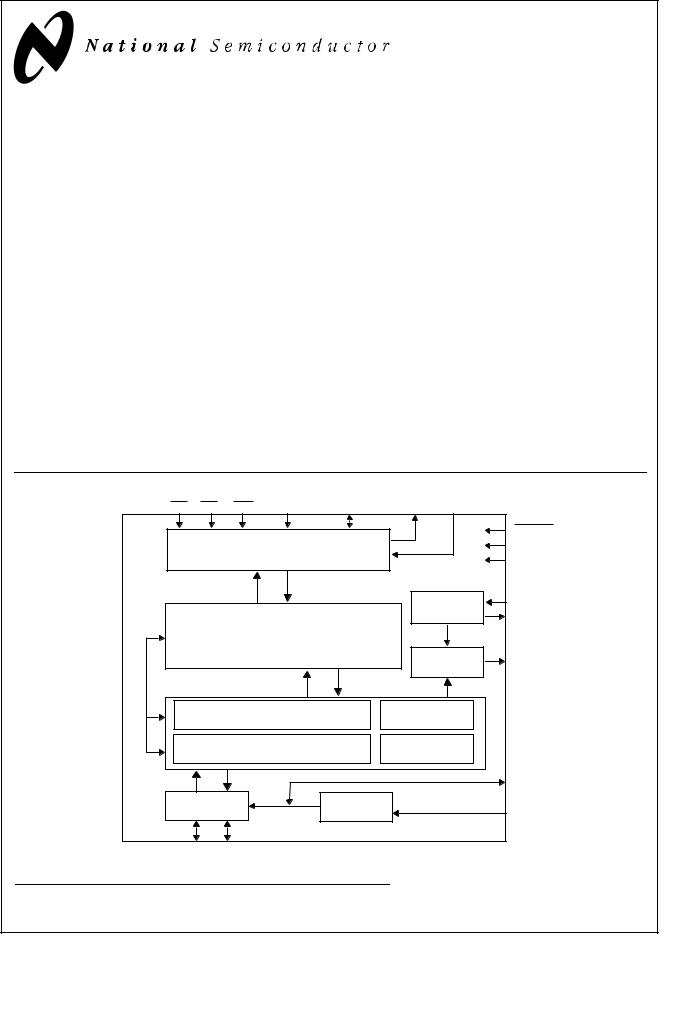
PRELIMINARY
March 2000
USBN9603 Universal Serial Bus
Full Speed Function Controller with Enhanced DMA Support
General Description
The USBN9603 is an integrated, USB Node controller that features enhanced DMA support with many automatic data handling features. It is compatible with USB specification versions 1.0 and 1.1, and is an advanced version of the currently available USBN9602.
A single IC integrates the required USB transceiver with a 3.3V regulator, a Serial Interface Engine (SIE), USB endpoint (EP) FIFOs, a versatile 8-bit parallel interface, a clock generator and a MICROWIRE/PLUS™ interface. Seven endpoint pipes are supported: one for the mandatory control endpoint and six to support interrupt, bulk and isochronous endpoints. Each endpoint pipe has a dedicated FIFO, 8 bytes for the control endpoint and 64 bytes for the other endpoints. The 8-bit parallel interface supports multiplexed and non-multiplexed style CPU address/data buses. A programmable interrupt output scheme allows device configuration for different interrupt signaling requirements.
Outstanding Features
●Low EMI, low standby current, 24 MHz oscillator
●Advanced DMA mechanism
●Fully static HALT mode with asynchronous wake-up for bus powered operation
●5V or 3.3V operation
●Improved input range 3.3V signal voltage regulator
●All unidirectional FIFOs are 64 bytes
●Power-up reset and startup delay counter simplify system design
●Simple programming model controlled by external controller
●Available in two packages
—USBN9603SLB: small footprint for new designs and portable applications
—USBN9603-28M: standard package, pin-to-pin compatible with USBN9602-28M
Block Diagram
CS |
RD |
WR |
A0/ALE D7-0/AD7-0 |
INTR MODE1-0 |
|
|
|
|
|
|
RESET |
|
Microcontroller Interface |
|
VCC |
||
|
|
|
|
|
GND |
|
|
|
|
24 MHz |
XIN |
|
|
|
|
Oscillator |
XOUT |
|
|
|
|
|
|
|
|
Endpoint/Control FIFOs |
|
|
|
|
|
|
|
Clock |
CLKOUT |
|
|
|
|
Generator |
|
|
|
|
|
|
|
Serial Interface Engine (SIE) |
|
|
|||
|
Media Access Controller (MAC) |
Clock |
|
||
|
Recovery |
|
|||
|
|
|
|
|
|
|
Physical Layer Interface (PHY) |
USB Event |
|
||
|
Detect |
|
|||
|
|
|
|
|
|
|
|
|
|
|
V3.3 |
Transceiver |
VReg |
|
AGND |
||
|
|
|
|
|
|
|
D+ |
D- |
Upstream Port |
|
|
TRI-STATE® is a registered trademark of National Semiconductor Corporation.
MICROWIRE/PLUS™ and MICROWIRE™ are trademarks of National Semiconductor Corporation.
© 2000 National Semiconductor Corporation |
www.national.com |
Support DMA Enhanced with Controller Function Speed Full Bus Serial Universal USBN9603

Features
●Full-speed USB node device
●USB transceiver
●24 MHz oscillator circuit
●Programmable clock generator
●Serial Interface Engine (SIE) consisting of Physical Layer Interface (PHY) and Media Access Controller (MAC), USB Specification 1.0 and 1.1 compliant
●Control/Status register file
●USB Function Controller with seven FIFO-based Endpoints:
—One bidirectional Control Endpoint 0 (8 bytes)
—Three Transmit Endpoints (64 bytes each)
—Three Receive Endpoints (64 bytes each)
●8-bit parallel interface with two selectable modes:
—Non-multiplexed
—Multiplexed (Intel compatible)
●Enhanced DMA support
—Automatic DMA (ADMA) mode for fully CPU-inde- pendent transfer of large bulk or ISO packets
—DMA controller, together with the USBN9603 ADMA logic, can transfer a large block of data in 64-byte packets via the USB
—Automatic Data PID toggling/checking and NAK packet recovery (maximum 256x64 bytes of data = 16K bytes)
●MICROWIRE/PLUSä interface
www.national.com |
2 |

Table of Contents
1.0Signal/Pin Connection and Description
1.1 |
CONNECTION DIAGRAMS ........................................................................................................ |
6 |
|
1.2 |
DETAILED SIGNAL/PIN DESCRIPTIONS .................................................................................. |
7 |
|
|
1.2.1 |
Power Supply ................................................................................................................ |
7 |
|
1.2.2 Oscillator, Clock and Reset ........................................................................................... |
7 |
|
|
1.2.3 |
USB Port ....................................................................................................................... |
8 |
|
1.2.4 |
Microprocessor Interface ............................................................................................... |
8 |
2.0Functional Overview
2.1 |
TRANSCEIVER ......................................................................................................................... |
10 |
2.2 |
VOLTAGE REGULATOR (VREG) ............................................................................................. |
10 |
2.3 |
SERIAL INTERFACE ENGINE (SIE) ......................................................................................... |
10 |
2.4 |
ENDPOINT PIPE CONTROLLER (EPC) ................................................................................... |
12 |
2.5 |
MICROCONTROLLER INTERFACE ......................................................................................... |
12 |
3.0Parallel Interface
3.1 |
NON-MULTIPLEXED MODE ..................................................................................................... |
13 |
|
|
3.1.1 |
Standard Access Mode ............................................................................................... |
14 |
|
3.1.2 |
Burst Mode .................................................................................................................. |
14 |
|
3.1.3 |
User Registers ............................................................................................................. |
14 |
3.2 |
MULTIPLEXED MODE .............................................................................................................. |
15 |
|
4.0Direct Memory Access (DMA) Support
4.1 |
STANDARD DMA MODE (DMA) ............................................................................................... |
16 |
4.2 |
AUTOMATIC DMA MODE (ADMA) ........................................................................................... |
17 |
5.0MICROWIRE/PLUS Interface
5.1 |
OPERATING COMMANDS ....................................................................................................... |
19 |
5.2 |
READ AND WRITE TIMING ...................................................................................................... |
20 |
6.0Functional Description
6.1 |
FUNCTIONAL STATES ............................................................................................................. |
22 |
|
|
6.1.1 |
Line Condition Detection ............................................................................................. |
22 |
|
6.1.2 |
Functional State Transition .......................................................................................... |
22 |
6.2 |
ENDPOINT OPERATION .......................................................................................................... |
24 |
|
|
6.2.1 |
Address Detection ....................................................................................................... |
24 |
|
6.2.2 Transmit and Receive Endpoint FIFOs ....................................................................... |
24 |
|
|
6.2.3 |
Programming Model .................................................................................................... |
28 |
6.3 |
POWER SAVING MODES ........................................................................................................ |
28 |
|
7.0Register Set
7.1 CONTROL REGISTERS ........................................................................................................... |
30 |
|
7.1.1 |
Main Control Register (MCNTRL) ............................................................................... |
30 |
7.1.2 |
Clock Configuration Register (CCONF)...................................................................... |
31 |
3 |
www.national.com |

Table of Contents (Continued)
|
7.1.3 |
Revision Identifier (RID) .............................................................................................. |
31 |
|
7.1.4 |
Node Functional State Register (NFSR) ..................................................................... |
32 |
|
7.1.5 |
Main Event Register (MAEV) ....................................................................................... |
32 |
|
7.1.6 |
Main Mask Register (MAMSK) .................................................................................... |
33 |
|
7.1.7 |
Alternate Event Register (ALTEV).............................................................................. |
33 |
|
7.1.8 |
Alternate Mask Register (ALTMSK) ............................................................................ |
34 |
|
7.1.9 |
Transmit Event Register (TXEV) ................................................................................. |
34 |
|
7.1.10 |
Transmit Mask Register (TXMSK) ............................................................................... |
35 |
|
7.1.11 |
Receive Event Register (RXEV) ................................................................................. |
35 |
|
7.1.12 |
Receive Mask Register (RXMSK) ............................................................................... |
35 |
|
7.1.13 |
NAK Event Register (NAKEV) .................................................................................... |
36 |
|
7.1.14 |
NAK Mask Register (NAKMSK) ................................................................................... |
36 |
7.2 |
TRANSFER REGISTERS .......................................................................................................... |
36 |
|
|
7.2.1 |
FIFO Warning Event Register (FWEV) ....................................................................... |
36 |
|
7.2.2 |
FIFO Warning Mask Register (FWMSK) ..................................................................... |
37 |
|
7.2.3 |
Frame Number High Byte Register (FNH) .................................................................. |
37 |
|
7.2.4 |
Frame Number Low Byte Register (FNL) .................................................................... |
37 |
|
7.2.5 |
Function Address Register (FAR) ................................................................................ |
38 |
|
7.2.6 |
DMA Control Register (DMACNTRL) .......................................................................... |
38 |
|
7.2.7 |
DMA Event Register (DMAEV) .................................................................................... |
39 |
|
7.2.8 |
DMA Mask Register (DMAMSK) ................................................................................. |
40 |
|
7.2.9 |
Mirror Register (MIR) ................................................................................................... |
41 |
|
7.2.10 |
DMA Count Register (DMACNT) ................................................................................. |
41 |
|
7.2.11 |
DMA Error Register (DMAERR) .................................................................................. |
41 |
|
7.2.12 |
Wake-Up Register (WKUP) ........................................................................................ |
42 |
|
7.2.13 |
Endpoint Control 0 Register (EPC0) ............................................................................ |
43 |
|
7.2.14 |
Transmit Status 0 Register (TXS0) ............................................................................. |
43 |
|
7.2.15 |
Transmit Command 0 Register (TXC0) ..................................................................... |
44 |
|
7.2.16 |
Transmit Data 0 Register (TXD0) ................................................................................ |
44 |
|
7.2.17 |
Receive Status 0 Register (RXS0) .............................................................................. |
44 |
|
7.2.18 |
Receive Command 0 Register (RXC0) ....................................................................... |
45 |
|
7.2.19 |
Receive Data 0 Register (RXD0) ................................................................................ |
45 |
|
7.2.20 |
Endpoint Control X Register (EPC1 to EPC6) ............................................................. |
46 |
|
7.2.21 |
Transmit Status X Register (TXS1, TXS2, TXS3) ....................................................... |
46 |
|
7.2.22 |
Transmit Command X Register (TXC1, TXC2, TXC3) ................................................ |
47 |
|
7.2.23 |
Transmit Data X Register (TXD1, TXD2, TXD3) ......................................................... |
48 |
|
7.2.24 |
Receive Status X Register (RXS1, RXS2, RXS3) ....................................................... |
48 |
|
7.2.25 |
Receive Command X Register (RXC1, RXC2, RXC3) ................................................ |
49 |
|
7.2.26 |
Receive Data X Register (RXD1, RXD2, RXD3) ......................................................... |
50 |
www.national.com |
4 |

Table of Contents (Continued)
7.3 REGISTER MAP ........................................................................................................................ |
50 |
8.0Device Characteristics
8.1 |
ABSOLUTE MAXIMUM RATINGS ............................................................................................ |
52 |
8.2 |
DC ELECTRICAL CHARACTERISTICS ................................................................................... |
52 |
8.3 |
AC ELECTRICAL CHARACTERISTICS .................................................................................... |
53 |
8.4 |
PARALLEL INTERFACE TIMING (MODE1-0 = 00B) ................................................................ |
54 |
8.5 |
PARALLEL INTERFACE TIMING (MODE1-0 = 01B) ................................................................ |
55 |
8.6 |
DMA SUPPORT TIMING ........................................................................................................... |
57 |
8.7 |
MICROWIRE INTERFACE TIMING (MODE1-0 = 10B) ............................................................. |
58 |
5 |
www.national.com |

1.0Signal/Pin Connection and Description
1.1CONNECTION DIAGRAMS
|
|
|
|
|
|
|
|
|
D2 |
D1 |
D0/SO |
A0/ALE/SI |
|
DACK |
DRQ |
INTR |
|
|
|
|
|
|
|
|
|
|
||||||||||||||
|
|
|
|
|
|
|
|
|
|
|
|
|
|
|
|
|
|
|
|
|||||||||||||||||||||
|
|
|
|
|
|
|
|
|
|
|
|
|
|
|
|
|
|
|
|
|
|
|
|
|
|
|
|
|
|
|
|
|
|
|
|
|
|
|
|
|
|
|
|
|
|
|
|
|
|
|
|
|
|
|
|
|
|
|
|
|
|
|
|
|
|
|
|
|
|
|
|
|
|
|
|
|
|
|
|
|
|
|
|
|
|
|
|
|
|
|
28 |
27 |
26 |
25 |
24 |
23 |
22 |
|
|
|
|
|
|
|
|
|
|
|||||||||||||||
|
D3 |
|
|
|
|
|
|
|
|
|
|
|
|
|
|
|
|
|
|
|
|
|
21 |
|
|
|
|
|
|
|
|
|
|
|||||||
|
|
|
|
|
1 |
|
|
|
|
|
|
|
|
|
|
|
|
|
|
|
|
|
|
|
|
|
|
WR/SK |
||||||||||||
|
|
|
|
|
|
|
|
|
|
|
|
|
|
|
|
|
|
|
|
|
|
|
||||||||||||||||||
|
|
|
|
|
|
|
|
|
|
|
|
|
|
|
|
|
|
|
|
|
|
|
|
|
|
|
|
20 |
|
|
|
|
|
|
|
|
|
|
||
|
|
|
|
|
|
|
|
|
2 |
|
|
|
|
|
|
|
|
|
|
|
|
|
|
|
|
|
|
|
|
|
|
|
RD |
|||||||
|
D4 |
|
|
|
|
|
|
|
|
|
|
|
|
|
|
|
|
|
|
|
|
|
||||||||||||||||||
|
|
|
|
|
|
|
|
|
|
|
|
|
|
|
|
|
|
|
|
|
|
|
|
|
|
|
|
|||||||||||||
|
D5 |
|
|
|
|
|
|
|
|
|
|
|
|
|
|
|
|
|
|
|
|
|
|
|
|
|
19 |
|
|
|
|
|
|
|
||||||
|
|
|
|
|
|
|
3 |
|
|
|
|
|
28-Pin CSP |
|
|
|
|
|
|
|
|
CS |
||||||||||||||||||
|
|
|
|
|
|
|
|
|
|
|
|
|
|
|
||||||||||||||||||||||||||
|
D6 |
|
|
|
|
|
|
|
|
|
|
|
|
|
|
|
18 |
|
|
|
|
|
CLKOUT |
|||||||||||||||||
|
|
|
|
|
|
|
4 |
|
|
|
|
|
|
|
|
|
|
|
|
|
|
|
|
|
|
|
|
|
|
|
||||||||||
|
|
|
|
|
|
|
|
|
|
|
|
|
|
|
|
|
|
|
|
|
|
|
|
|
||||||||||||||||
|
D7 |
|
|
|
|
|
|
5 |
|
|
|
|
|
|
|
|
|
|
|
|
|
|
|
|
|
|
17 |
|
|
|
|
|
XOUT |
|||||||
|
|
|
|
|
|
|
|
|
|
|
|
|
|
|
|
|
|
|
|
|
|
|
|
|
||||||||||||||||
|
|
|
|
|
|
|
|
|
|
|
|
|
|
|
|
|
|
|
|
|
|
|
|
|
|
|
|
16 |
|
|
|
|
|
XIN |
||||||
RESET |
|
|
|
|
|
|
6 |
|
|
|
|
|
|
|
|
|
|
|
|
|
|
|
|
|
|
|||||||||||||||
|
|
|
|
|
|
|
|
|
|
|
|
|
|
|
|
|
|
|
|
|
|
|
|
|
|
|||||||||||||||
|
AGND |
|
|
|
|
7 |
|
|
9 |
|
|
|
|
|
|
|
|
|
|
|
|
|
15 |
|
|
|
|
|
MODEO |
|||||||||||
|
|
|
|
|
|
|
|
|
|
|
|
|
|
|
|
|
|
|
|
|
||||||||||||||||||||
|
|
|
|
|
|
|
|
|
8 |
10 |
11 |
12 |
13 |
14 |
|
|
|
|
|
|
|
|
|
|
||||||||||||||||
|
|
|
|
|
|
|
|
|
|
|
|
|
|
|
|
|
|
|
|
|
|
|
|
|
|
|
|
|
|
|
|
|
|
|
|
|
|
|
|
|
|
|
|
|
|
|
|
|
|
|
|
|
|
|
|
|
|
|
|
|
|
|
|
|
|
|
|
|
|
|
|
|
|
|
|
|
|
|
|
|
|
|
|
|
|
|
|
|
|
|
V3.3 |
D+ |
D− |
GND |
|
V |
GND |
MODE1 |
|
|
|
|
|
|
|
|
|
|
||||||||||||||
|
|
|
|
|
|
|
|
|
|
|
|
|
|
|
|
|
|
|
|
|
|
|
|
CC |
|
|
|
|
|
|
|
|
|
|
|
|
|
|
|
|
USBN9603SLB
|
|
|
|
|
|
|
|
1 |
28 |
|
|
CLKOUT |
||
|
|
|
|
CS |
|
|
|
|||||||
|
|
|
|
|
|
|||||||||
|
|
|
|
|
|
|
||||||||
|
|
|
|
|
|
|
2 |
27 |
|
|
XOUT |
|||
|
|
|
RD |
|||||||||||
|
|
|
|
|
|
|
|
|||||||
|
|
|
|
|
|
|
|
|||||||
|
|
|
|
|
|
3 |
26 |
|
|
|
|
|||
|
WR/SK |
|
|
|
XIN |
|||||||||
|
|
|
||||||||||||
|
|
|
|
|||||||||||
|
|
INTR |
|
4 |
25 |
|
|
MODE0 |
||||||
|
|
|
|
|||||||||||
|
|
|
|
|
||||||||||
|
|
DRQ |
|
5 |
24 |
|
|
MODE1 |
||||||
|
|
|
|
|||||||||||
|
|
|
|
|
||||||||||
|
|
|
|
|
|
|
6 |
23 |
|
|
GND |
|||
|
DACK |
|||||||||||||
|
|
|
|
|
|
|
|
|||||||
|
|
|
|
|
|
|
|
|||||||
A0/ALE/SI |
|
|
7 |
28-Pin SO 22 |
|
|
Vcc |
|||||||
|
|
|
|
|||||||||||
|
|
|
|
|||||||||||
|
D0/SO |
|
|
8 |
21 |
|
|
GND |
||||||
|
|
|
|
|
||||||||||
|
|
|
|
|
||||||||||
|
|
|
|
D1 |
|
|
9 |
20 |
|
|
D– |
|||
|
|
|
|
|
|
|
|
|||||||
|
|
|
|
|
|
|
|
|||||||
|
|
|
|
D2 |
|
|
10 |
19 |
|
|
D+ |
|||
|
|
|
|
|
|
|
|
|||||||
|
|
|
|
|
|
|
|
|||||||
|
|
|
|
D3 |
|
11 |
18 |
|
|
V3.3 |
||||
|
|
|
|
|
|
|
|
|||||||
|
|
|
|
|
|
|
||||||||
|
|
|
|
D4 |
|
12 |
17 |
|
|
AGND |
||||
|
|
|
|
|
|
|
|
|||||||
|
|
|
|
|
|
|
||||||||
|
|
|
|
|
|
|
13 |
16 |
|
|
|
|
||
|
|
|
|
D5 |
|
|
|
RESET |
||||||
|
|
|
|
|
|
|
||||||||
|
|
|
|
|
|
|
|
|||||||
|
|
|
|
D6 |
|
14 |
15 |
|
|
D7 |
||||
|
|
|
|
|
|
|||||||||
|
|
|
|
|
|
|
||||||||
|
|
|
|
|
|
|
|
|
|
|
|
|
|
|
USBN9603-28M
www.national.com |
6 |

1.0 Signal/Pin Connection and Description (Continued)
1.2DETAILED SIGNAL/PIN DESCRIPTIONS
1.2.1Power Supply
I/O |
Name |
Description |
|
|
|
|
|
|
NA |
Vcc |
Digital Power Supply (VCC) |
|
|
|
NA |
GND |
Digital Power Supply (GND) |
|
|
|
NA |
AGND |
Analog Power Supply (AGND) |
|
|
|
NA |
V3.3 |
Transceiver 3.3V Voltage Supply. This pin can be used as the internal 3.3V voltage regulator |
|
|
output. The regulator is intended to power only the internal transceiver and one external pull-up. |
|
|
An external 1 μF de-coupling capacitor is required on this pin. The voltage regulator output is dis- |
|
|
abled upon reset. When the internal voltage regulator is left disabled, this pin must be used as a |
|
|
3.3V supply input for the internal transceiver. This is the case during 3.3V operation. |
|
|
|
1.2.2Oscillator, Clock and Reset
I/O |
|
Name |
Description |
|
|
|
|
||
|
|
|
||
NA |
XIN |
Crystal Oscillator Input. Input for internal 24 MHz crystal oscillator circuit. A 24 MHz funda- |
||
|
|
|
|
mental crystal may be used. |
|
|
|
||
NA |
XOUT |
Crystal Oscillator Output |
||
|
|
|
||
O |
CLKOUT |
Clock Output. This pin provides a programmable clock source. Upon hardware reset, this pin |
||
|
|
|
|
sources a 4 MHz clock (there may be an initial phase discontinuity). It may be disabled, or con- |
|
|
|
|
figured for different speeds, via the Clock Configuration register |
|
|
|
|
|
I |
|
|
|
Reset. This signal is active low. Signal conditioning is provided on this input to suppose use of |
RESET |
||||
|
|
|
|
a simple, RC power-on reset circuit. |
|
|
|
|
|
Oscillator Circuit
The XIN and XOUT pins may be connected to make a 24 MHz closed-loop ,crystal-controlled oscillator. Alternately, an external 24 MHz clock source may be input to clock the device. The internal crystal oscillator uses a 24 MHz fundamental crystal. See Table 1 for typical component values and Figure 1 for the crystal circuit. For a specific crystal, please consult the manufacturer for recommended component values.
If an external clock source is used, it is connected to XIN. XOUT should remain unconnected. Stray capacitance and inductance should be kept as low as possible in the oscillator circuit. Trace lengths should be minimized by positioning the crystal and external components as close as possible to the XIN and XOUT pins.
Table 1. Approximate Component Values
Component |
Parameters |
Values |
Tolerance |
|
|
|
|
|
|
|
|
Crystal Resonator |
Resonance Frequency |
24 MHz |
N/A |
|
|
|
|
|
Type |
AT-Cut |
|
|
|
|
|
|
Maximum Serial Resistance |
50 Ω |
|
|
|
|
|
|
Maximum Shunt Capacitance |
10 pF |
|
|
|
|
|
|
Load Capaciitance |
20 pF |
|
|
|
|
|
Resistor R1 |
|
1 MΩ |
±5% |
|
|
|
|
|
|
|
|
Resistor R2 |
|
0 |
ΝΑ |
|
|
|
|
|
|
|
|
Capacitor C1 |
|
15 pF |
±20% |
|
|
|
|
|
|
|
|
Capacitor C2 |
|
15 pF |
±20% |
|
|
|
|
|
|
|
|
7 |
www.national.com |
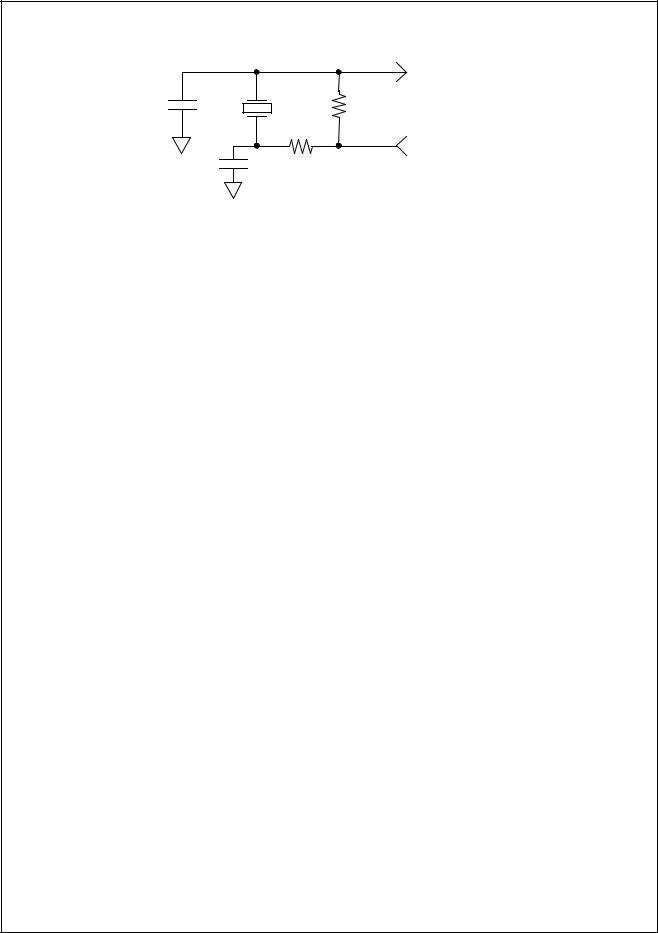
1.0 Signal/Pin Connection and Description (Continued)
|
XIN |
|
XTAL |
C1 |
R1 |
|
XOUT |
C2 |
R2 |
Figure 1. Typical Oscillator Circuit
1.2.3USB Port
I/O |
Name |
Description |
|
|
|
|
|
|
I/O |
D+ |
USB D+ Upstream Port. This pin requires an external 1.5k pull-up to 3.3V to signal full speed |
|
|
operation. |
|
|
|
I/O |
D– |
USB D– Upstream Port |
|
|
|
1.2.4Microprocessor Interface
I/O |
|
Name |
Description |
||||||
|
|
|
|||||||
I |
MODE1-0 |
Interface Mode. Each of these pins should be hard-wired to VCC or GND to select the inter- |
|||||||
|
|
|
|
|
|
|
|
|
face mode: |
|
|
|
|
|
|
|
|
|
MODE1-0 = 00. Mode 0: Non-multiplexed parallel interface mode |
|
|
|
|
|
|
|
|
|
MODE1-0 = 01. Mode 1: Multiplexed parallel interface mode |
|
|
|
|
|
|
|
|
|
MODE1-0 = 10. Mode 2: MICROWIRE interface mode |
|
|
|
|
|
|
|
|
|
MODE1-0 = 11. Mode 3: Reserved |
|
|
|
|
|
|
|
|
|
Note: Mode 3 also selects the MICROWIRE interface mode in the USBN9602, but this mode |
|
|
|
|
|
|
|
|
|
should be reserved to preserve compatibility with future devices. |
|
|
|
|
|
|
|
|
|
|
I |
|
|
|
|
|
|
|
|
DMA Acknowledge. This active low signal is only used if DMA is enabled. If DMA is not used, |
|
DACK |
||||||||
|
|
|
|
|
|
|
|
|
this pin must be tied to VCC. |
O |
|
DRQ |
DMA Request. This pin is used for DMA request only if DMA is enabled. |
||||||
|
|
|
|
||||||
O |
|
INTR |
Interrupt. The interrupt signal modes (active high, active low or open drain) can be config- |
||||||
|
|
|
|
|
|
|
|
|
ured via the Main Control register. During reset, this signal is TRI-STATE. |
|
|
|
|
|
|
|
|
|
|
I |
|
|
|
|
|
|
|
Chip Select. Active low chip select |
|
|
|
|
CS |
||||||
|
|
|
|
|
|
|
|
||
I |
|
|
|
|
|
|
|
Read. Active low read strobe, parallel interface |
|
|
RD |
||||||||
|
|
|
|
|
|
||||
I |
|
|
|
|
|
|
|
Write. Active low write strobe, parallel interface |
|
|
WR |
||||||||
|
|
|
|
|
|
||||
|
|
|
|
SK |
MICROWIRE Shift Clock. Mode 2 |
||||
|
|
|
|
|
|
||||
I |
|
|
|
A0 |
A0 Address Bus Line. Mode 0, parallel interface |
||||
|
|
|
|
||||||
|
|
ALE |
Address Latch Enable. Mode 1, parallel interface |
||||||
|
|
|
|
|
|
||||
|
|
|
|
SI |
MICROWIRE Serial Input. Mode 2 |
||||
|
|
|
|
|
|
||||
I/O |
|
|
|
D0 |
Data Bus Line D0. Mode 0 |
||||
|
|
|
|
||||||
|
|
AD0 |
Address/Data Bus LIne AD0. Mode 1 |
||||||
|
|
|
|
|
|||||
|
|
|
SO |
MICROWIRE Serial Output. Mode 2 |
|||||
|
|
|
|
|
|
||||
I/O |
|
|
|
D1 |
Data Bus Line D1. Mode 0 |
||||
|
|
|
|
||||||
|
|
AD1 |
Address/Data Bus Line AD1. Mode 1 |
||||||
|
|
|
|
|
|
|
|
|
|
www.national.com |
8 |

1.0 Signal/Pin Connection and Description (Continued)
I/O |
D2 |
Data Bus Line D2. Mode 0 |
|
|
|
|
AD2 |
Address/Data Bus Line AD2. Mode 1 |
|
|
|
I/O |
D3 |
Data Bus Line D3. Mode 0 |
|
|
|
|
AD3 |
Address/Data Bus Line AD3. Mode 1 |
|
|
|
I/O |
D4 |
Data Bus Line D4. Mode 0 |
|
|
|
|
AD4 |
Address/Data Bus Line AD4. Mode 1 |
|
|
|
I/O |
D5 |
Data Bus Line D5. Mode 0 |
|
|
|
|
AD5 |
Address/Data Bus Line AD5. Mode 1 |
|
|
|
I/O |
D6 |
Data Bus Line D6. Mode 0 |
|
|
|
|
AD6 |
Address/Data Bus Line AD6. Mode 1 |
|
|
|
I/O |
D7 |
Data Bus Line D7. Mode 0 |
|
|
|
|
AD7 |
Address/Data Bus Line AD7. Mode 1 |
|
|
|
9 |
www.national.com |

2.0Functional Overview
The USBN9603 is a Universal Serial Bus (USB) Node controller compatible with USB Specification, 1.0 and 1.1. It integrates onto a single IC the required USB transceiver with a 3.3V regulator, the Serial Interface Engine (SIE), USB endpoint FIFOs, a versatile (8-bit parallel or serial) interface and a clock generator. A total of seven endpoint pipes are supported: one bidirectional for the mandatory control EP0 and an additional six for unidirectional endpoints to support USB interrupt, bulk and isochronous data transfers. The 8-bit parallel interface supports multiplexed and non-multiplexed style CPU address/data buses. The synchronous serial MICROWIRE interface allows adapting to CPUs without external address/data buses. A programmable interrupt output scheme allows adapting to different interrupt signaling requirements.
Refer to Figure 2 for the USBN9603 major functional blocks, described in the following sections.
2.1TRANSCEIVER
The USBN9603 contains a high-speed transceiver which consists of three main functional blocks:
—Differential receiver
—Single-ended receiver with on-chip voltage reference
—Transmitter with on-chip current source.
This transceiver meets the performance requirements described in Chapter 7 of the USB Specification, Version 1.1.
To minimize signal skew, the differential output swings of the transmitter are well balanced. Slew-rate control is used on the driver to minimize radiated noise and crosstalk. The drivers support TRI-STATE operation to allow bidirectional, half-duplex operation of the transceiver.
The differential receiver operates over the complete common mode range, and has a delay guaranteed to be larger than that of the single-ended receivers. This avoids potential glitches in the Serial Interface Engine (SIE) after single-ended zeros.
Single-ended receivers are present on each of the two data lines. These are required, in addition to the differential receiver, to detect an absolute voltage with a switching threshold between 0.8V and 2.0V (TTL inputs). To increase Vcc rejection, without glitching, a voltage reference sets the single-ended switching reference. An external 1.5 ± 5% KΩ resistor is required on D+ to indicate that this is a high-speed node. This resistor should be tied to a voltage source between 3.0V and 3.6V, and referenced to the local ground, such as the output provided on pin V3.3.
2.2VOLTAGE REGULATOR (VREG)
The voltage regulator provides 3.3V for the integrated transceiver from 5.0V device power or USB bus power. This output can be used to supply power to the 1.5 KΩ pull-up resistor. This output must be decoupled with a 1 μF tantalum capacitor to ground. It can be disabled under software control to allow using the device in a 3.3V system.
2.3SERIAL INTERFACE ENGINE (SIE)
The SIE is comprised of physical (PHY) and Media Access Controller (MAC) modules. The PHY module includes the digitalclock recovery circuit, a digital glitch filter, End Of Packet (EOP) detection circuitry, and bit stuffing and unstuffing logic. The MAC module includes packet formatting, CRC generation and checking, and endpoint address detection. It provides the necessary control to give the NAK, ACK and STALL responses as determined by the Endpoint Pipe Controller (EPC) for the specified endpoint pipe. The SIE is also responsible for detecting and reporting USB-specific events, such as NodeReset, NodeSuspend and NodeResume. The module output signals to the transceiver are well matched (under 1 nS) to minimize skew on the USB signals.
The USB specifications assign bit stuffing and unstuffing as the method to ensure adequate electrical transitions on the line to enable clock recovery at the receiving end. The bit stuffing block ensures that whenever a string of consecutive 1’s is encountered, a 0 is inserted after every sixth 1 in the data stream. The bit unstuffing logic reverses this process.
The clock recovery block uses the incoming NRZI data to extract a data clock (12 MHz) from a 48 MHz input clock. This input clock is derived from a 24 MHz oscillator in conjunction with PLL circuitry (clock doubler). This clock is used in the data recovery circuit. The output of this block is binary data (decoded from the NRZI stream) which can be appropriately sampled using the extracted 12 MHz clock. The jitter performance and timing characteristics meet the requirements set forth in Chapter 7 of the USB Specification.
www.national.com |
10 |
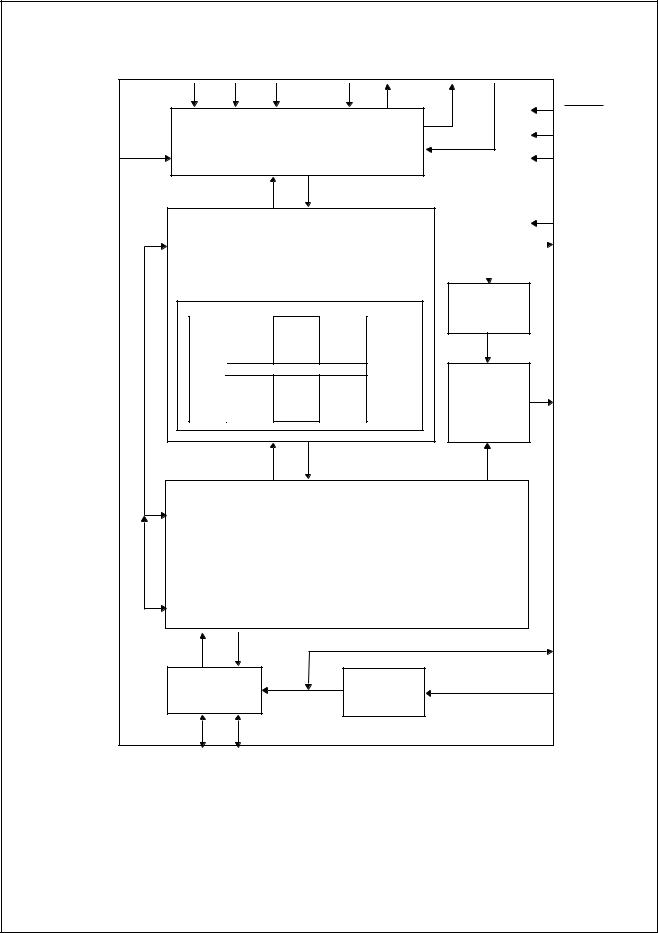
2.0 Functional Overview (Continued)
|
|
|
|
|
|
|
|
|
CS RD WR/SK |
DACK DRQ |
INTR MODE1-0 |
||||||
D7-0/AD7-0/SO 

Microcontroller Interface
(Parallel and Serial)
A0/ALE/SI
Endpoint/Control FIFOs |
|
|
24 MHz |
|
||
|
|
|
|
Oscillator |
|
|
|
|
|
|
|
||
|
|
|
|
|
|
|
Control |
|
Status |
|
|
|
|
|
|
|
|
|
|
|
|
|
|
|
PLL |
Endpoint0 |
EP2EP1 |
EP6EP5 |
|
x 2 |
RX |
|
|||
|
|
|
|
|
|
|
|
TX |
Clock |
|
|
|
Generator |
|
|
|
|
|
SIE
Media Access Controller (MAC) |
|
Clock |
|
Recovery |
|
|
|
|
|
|
|
Physical Layer Interface (PHY) |
|
USB Event |
|
Detect |
|
|
|
|
|
|
|
Transceiver |
VReg |
D+ D- |
Upstream Port |
|
Figure 2. USBN9603 Block Diagram
RESET
VCC
GND
XIN
XOUT
CLKOUT
V3.3
AGND
11 |
www.national.com |
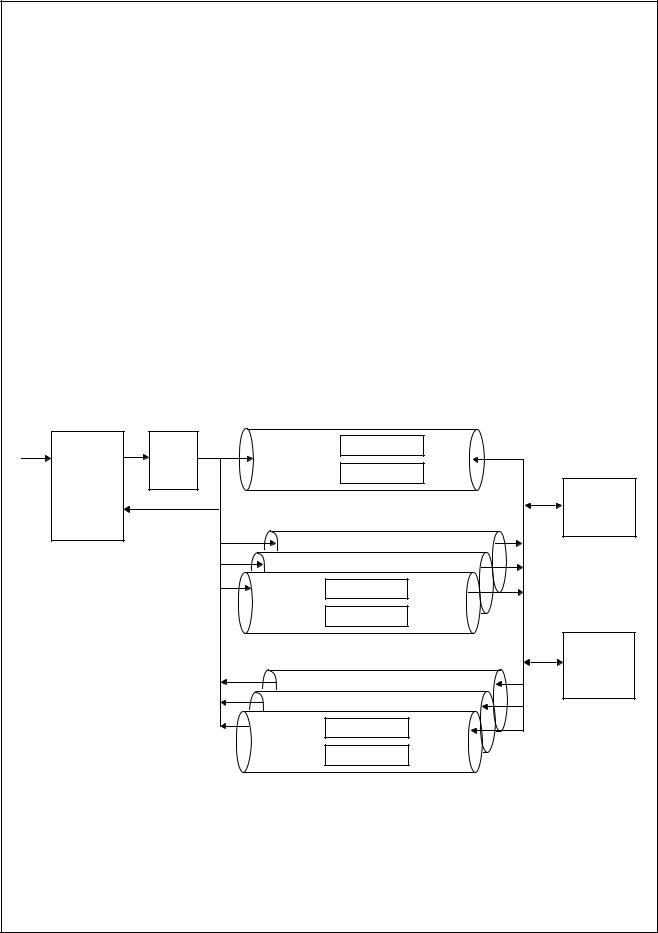
2.0 Functional Overview (Continued)
2.4ENDPOINT PIPE CONTROLLER (EPC)
The EPC provides the interface for USB function endpoints. An endpoint is the ultimate source or sink of data. An endpoint pipe facilitates the movement of data between USB and memory, and completes the path between the USB host and the function endpoint. According to the USB specification, up to 31 such endpoints are supported at any given time. USB allows a total of 16 unidirectional endpoints for receive and 16 for transmit. As the control endpoint 0 is always bidirectional, the total number is 31. The USBN9603 supports a maximum of seven endpoint pipes with the same function address. See Figure 3 for a schematic diagram of EPC operation.
A USB function is a USB device that is able to transmit and receive information on the bus. A function may have one or more configurations, each of which defines the interfaces that make up the device. Each interface, in turn, is composed of one or more endpoints.
Each endpoint is an addressable entity on USB and is required to respond to IN and OUT tokens from the USB host (typically a PC). IN tokens indicate that the host has requested to receive information from an endpoint, and OUT tokens indicate that it is about to send information to an endpoint.
On detection of an IN token addressed to an endpoint, the endpoint pipe should respond with a data packet. If the endpoint pipe is currently stalled, a STALL handshake packet is sent under software control. If the endpoint pipe is enabled but no data is present, a NAK (Negative Acknowledgment) handshake packet is sent automatically. If the endpoint pipe is isochronous and enabled but no data is present, a bit stuff error followed by an end of packet is sent on the bus.
Similarly, on detection of an OUT token addressed to an endpoint, the endpoint pipe should receive a data packet sent by the host and load it into the appropriate FIFO. If the endpoint pipe is stalled, a STALL handshake packet is sent. If the endpoint pipe is enabled but no buffer is present for data storage, a NAK handshake packet is sent. If the endpoint is isochronous and enabled but cannot handle the data, no handshake packet is sent.
A disabled endpoint does not respond to IN, OUT, or SETUP tokens.
The EPC maintains separate status and control information for each endpoint pipe.
For IN tokens, the EPC transfers data from the associated FIFO to the host. For OUT tokens, the EPC transfers data in the opposite direction.
USB |
Function |
|
Control Registers |
|
EP0 |
|
|
||
|
Address |
FIFOs |
|
|
|
Compare |
|
|
|
|
USB SIE |
|
|
|
|
|
|
Control Endpoint Pipe |
DMA |
|
|
|
Controller |
|
|
|
|
|
|
|
|
|
EPA |
|
|
|
EPB |
|
|
|
|
EPC. |
Control Registers |
|
|
|
|
FIFO |
|
|
|
|
Receive Endpoint Pipes |
Microcontroller |
|
|
|
|
|
|
|
|
EPX |
Interface |
|
|
|
|
|
|
|
EPY |
|
|
|
|
EPZ |
Control Registers |
|
|
|
|
FIFO |
|
|
|
|
Transmit Endpoint Pipes |
|
Figure 3. EPC Operation
2.5MICROCONTROLLER INTERFACE
A CPU or microcontroller can be connected via an 8-bit parallel interface or a MICROWIRE interface. The interface type is selected via device input pin MODE1. For the parallel interface, the addressing mode (multiplexed or non-multiplexed) is selected via device input pin MODE0. In addition, a configurable interrupt output is provided. The interrupt type can be configured to be either open-drain active-low or push-pull active high or low.
www.national.com |
12 |
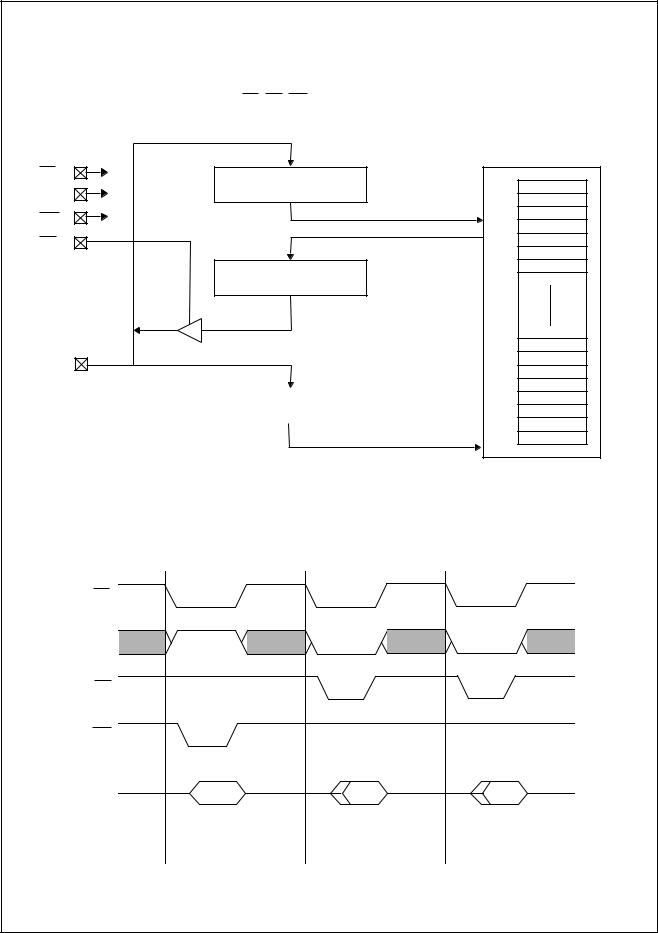
3.0Parallel Interface
The parallel interface allows the USBN9603 to function as a CPU or microcontroller peripheral. Non-multiplexed or multiplexed more are selected via the MODE0 and MODE1 pins .
3.1NON-MULTIPLEXED MODE
Non-multiplexed mode uses the control pins CS, RD, WR, the address pin A0 and the bidirectional data bus D7-0 as shown in Figure 4. This mode is selected by tying both the MODE1 and MODE0 pins to GND.
CS |
|
DATA_IN |
0x00 |
A0 |
Data In |
|
|
WR |
|
RD |
Data Out |
|
|
DATA_OUT |
|
D7-0
ADDR |
Address |
|
|
0x3F
Register File
Figure 4. Non-Multiplexed Mode Block Diagram
The CPU has direct access to the DATA_IN, DATA_OUT and ADDR registers. Reading and writing data to the USBN9603 can be done either in standard access or burst mode. See Figure 5 for timing information.
CS |
|
|
|
A0 |
|
|
|
RD |
|
|
|
WR |
|
|
|
D7-0 |
Input |
Out |
Out |
|
Write Address |
Read Data |
Burst Read Data |
|
Figure 5. Non-Multiplexed Mode Timing Diagram |
|
|
13 |
www.national.com |

3.0Parallel Interface (Continued)
3.1.1Standard Access Mode
The standard access sequence for non-multiplexed mode is to write the address to the ADDR register and then read or write the data from/to the DATA_OUT/DATA_IN register. The DATA_OUT register is updated after writing to the ADDR register. The ADDR register or the DATA_OUT/DATA_IN register is selected with the A0 input.
3.1.2Burst Mode
In burst mode, the ADDR register is written once with the desired memory address of any of the on-chip registers. Then consecutive reads/writes are performed to the DATA_IN/DATA_OUT register without previously writing a new address. The content of the DATA_OUT register for read operations is updated once after every read or write.
3.1.3User Registers
The following table gives an overview of the parallel interface registers in non-multiplexed mode.
The reserved bits return undefined data on read and should be written with 0.
A0 |
Access |
bit 7 |
bit 6 |
bit 5 |
bit 4 |
bit 3 |
bit 2 |
bit 1 |
bit 0 |
|
|
|
|
|
|
|
|
|
|
0 |
Read |
|
|
|
DATA_OUT |
|
|
|
|
|
|
|
|
|
|
|
|
|
|
0 |
Write |
|
|
|
DATA_IN |
|
|
|
|
|
|
|
|
|
|
|
|
|
|
1 |
Read |
|
|
|
Reserved |
|
|
|
|
|
|
|
|
|
|
|
|
|
|
1 |
Write |
Reserved |
|
|
ADDR5-0 |
|
|
||
|
|
|
|
|
|
|
|
|
|
Address Register (ADDR)
The ADDR register acts as a pointer to the internal memory. This register is write only and is cleared on reset.
Data Output Register (DATA_OUT)
The DATA_OUT register is updated with the contents of the memory register to which the ADDR register is pointing. Update occurs under the following conditions:
1.After the ADDR register is written.
2.After a read from the DATA_OUT register.
3.After a write to the DATA_IN register.
This register is read only and holds undefined data after reset.
Data Input Register (DATA_IN)
The DATA_IN register holds the data written to the USBN9603 address to which ADDR points. This register is write only and is cleared on reset.
www.national.com |
14 |
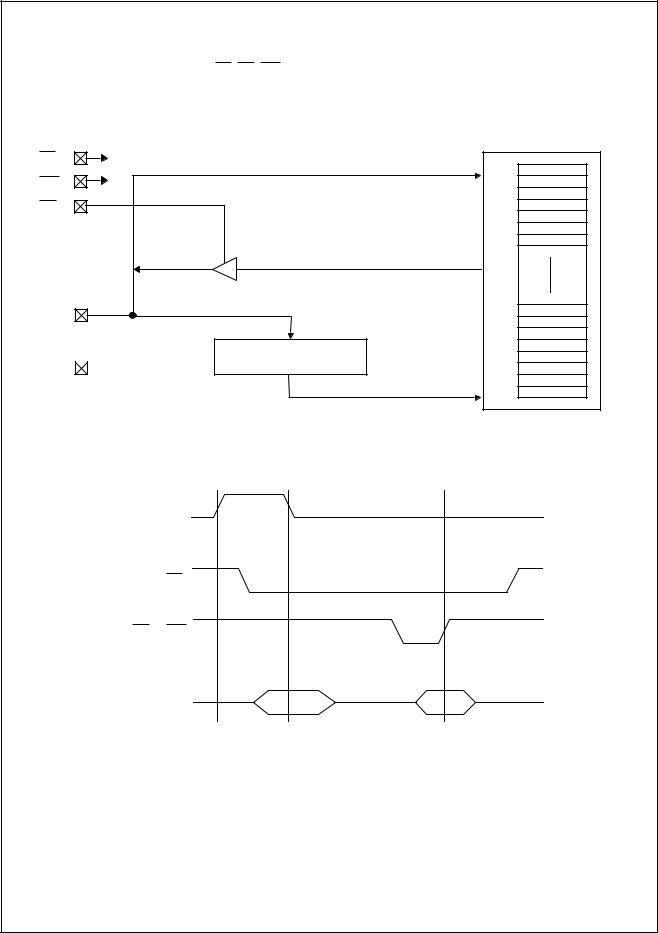
3.0 Parallel Interface (Continued)
3.2MULTIPLEXED MODE
Multiplexed mode uses the control pins CS, RD, WR, the address latch enable signal ALE and the bidirectional address data bus AD7-0 as shown in Figure 6. This mode is selected by tying MODE1 to GND and MODE0 to VCC. The address is latched into the ADDR register when ALE is high. Data is output/input with the next active RD or WR signal. All registers are directly accessible in this interface mode.
Figure 7 shows basic timing of the interface in Multiplexed mode.
CS
Data In |
0x00 |
WR
RD
Data Out
AD7-0
ADDR
ALE  EN
EN
Address 0x3F
Register File
Figure 6. Multiplexed Mode Block Diagram
ALE
CS
RD or WR
AD7-0 |
ADDR |
DATA |
Figure 7. Multiplexed Mode Basic Read/Write Timing
15 |
www.national.com |

4.0Direct Memory Access (DMA) Support
The USBN9603 supports DMA transfers with an external DMA controller from/to endpoints 1 to 6. This mode uses the device pins DRQ and DACK in addition to the parallel interface pins RD or WR and D7-0 data pins. DMA mode can only be used with parallel interface mode (MODE1 must be grounded). The read or write address is generated internally and the state of the A0/ALE pin is ignored during a DMA cycle.
The DMA support logic has a lower priority than the parallel interface. CS must stay inactive during a DMA cycle. If CS becomes active, DACK is ignored and a regular read/write operation is performed. Only one endpoint can be enabled at any given time to issue a DMA request when data is received or transmitted.
Two different DMA modes are supported: standard and automatic.
4.1STANDARD DMA MODE (DMA)
To enable DMA transfers in standard DMA mode, the following steps must be performed:
1.The local CPU programs the DMA controller for fly-by demand mode transfers. In this mode, transfers occur only when the USBN9603 requests them via the DRQ pin. The data is read/written from/to the USBN9603 receive/transmit FIFO and written/read into/from local memory during the same bus transaction.
2.The DMA address counter is programmed to point to the destination memory block in the local shared memory, and the Byte Count register is programmed with the number of bytes in the block to be transferred. If required the automatic error handling should be enabled at this point along with the error handling counter. In addition the user needs to set the respective Endpoint enable bit.
3.The DMA Enable bit and DMA Source bits are set in the USBN9603.
4.The USB host can now perform USB bulk or isochronous data transfers over the USB bus to the receive FIFO or from the transmit FIFO in the USBN9603.
5.If the FIFOs warning limit is reached or the transmission/reception is completed, a DMA request/acknowledge sequence is initiated for the predetermined number of bytes. The time at which a DMA request is issued depends on the selected DMA mode (controlled by the DMOD bit in the DMACNTRL register), the current status of the endpoint FIFO, and the FIFO warning enable bits. A DMA request can be issued immediately.
6.After the DMA controller has granted control of the bus, it drives a valid memory address and asserts DACK and RD or WR, thus transferring a byte from the USBN9603 receive FIFO to memory, or from memory to the transmit FIFO. This process continues until the DMA byte count, within the DMA controller, reaches zero.
7.After the programmed amount of data is transferred, the firmware must do one of the following (depending on the transfer direction and mode):
—Queue the new data for transmission by setting the TX_EN bit in the TXCx register.
—Set the End Of Packet marker by setting the TX_LAST bit in the TXCx register. Re-enable reception by setting the RX_EN bit in the RXCx register.
—Check if the last byte of the packet was received (RX_LAST bit in the RXSx register).
The DMA transfer can be halted at any time by resetting the USBN9603 DMA request enable bit. If the USBN9603 DMA request enable bit is cleared during the middle of a DMA cycle, the current cycle is completed before the DMA request is terminated.
See Figures 8 and 9 for the transmit oand receive sequences using standard DMA mode.
|
MIcrocontroller |
|
DMA |
Microcontroller |
USB |
|
DMA |
|
|
|
|||||
|
|
|
|
|
|
|
|
|
|
|
|
|
|
|
time |
|
|
|
|
|
|
|
|
|
|
|
|
|
|
|
|
|
Set up DMA |
|
Fill FIFO |
|
|
Transaction |
|
Fill FIFO |
|
|
|||||
|
|
Enable TX |
|
|
|||||||||||
|
|
|
|
|
|
||||||||||
Figure 8. Transmit Operation in Standard DMA Mode
Microcontroller |
Microcontroller USB |
DMA |
|
Microcontroller |
|
|
|
|||||
|
|
|
|
|
|
|
|
|
|
|
|
time |
|
|
|
|
|
|
|
|
|
|
|
|
|
|
|
|
Read FIFO |
|
Enable RX |
|
|
|||||
Set up DMA |
Enable RX Transaction |
|
|
|||||||||
|
|
|
|
|||||||||
Figure 9. Receive Operation using Standard DMA
www.national.com |
16 |

4.0 Direct Memory Access (DMA) Support (Continued)
4.2AUTOMATIC DMA MODE (ADMA)
ADMA mode allows CPU independent transfer of large bulk or isochronous data streams to or from the USB bus. The applications DMA controller together with the ADMA logic inside the USBN9603 have the capability to split a large amount of data and transfer it in (FIFO size) packets via the USB. In addition, automatic error handling is performed by the USBN9603 in order to minimize firmware intervention. The number of transferred data stream bytes must be of a modulo 64 size. The maximum amount of data is restricted to 256*64 bytes = 16 Kbytes.
To enable an ADMA transfer, the following steps must be performed:
1.The local CPU programs the DMA controller for fly-by demand mode transfers. In this mode, transfers occur only in response to USBN9603 request via the DRQ pin. The data is read/written from/to the USBN9603 receive/transmit FIFO and written/read into/from local memory during the same bus transaction.
2.The DMA address counter is programmed to point to the destination memory block in the local shared memory, and the Byte Count register is programmed with the number of bytes in the block to be transferred. The DMA Count register must be configured with the number of packets to be received or transmitted. If required, the Automatic Error Handling register must also be configured at this time.
3.The ADMA enable bit must be set prior to, or at the same time as the DMA enable bit. The DMA enable bit must be cleared before enabling ADMA mode.
4.The DMA request enable bit and DMA source bits are set in the USBN9603.The respective endpoint enable bit must also be set.
5.The USB host can now perform USB bulk or isochronous data transfers over the USB bus to the receive FIFO or from the transmit FIFO in the USBN9603. The USBN9603 performs steps 5 to 7 of the normal DMA mode automatically. The ADMA is stopped either when the last packet is received or the DMA Count register has reached the value zero.
See Figures 10 and 11 for the transmit and receive sequences using ADMA mode. See Figures 12 and 13 for the basic DMA write timing and read timing.
Microcontroller |
DMA |
USB |
DMA |
USB |
|
|
|
USB |
|
||
|
|
|
|
|
|
|
|
|
|
time |
|
|
|
|
|
|
|
|
|
|
|
|
|
|
|
|
|
|
|
|
|
|
|
||
Set up ADMA |
Fill FIFO |
Transaction |
Fill FIFO |
Transaction |
|
|
Last |
||||
|
|
|
|
|
|
|
|
Transaction |
|||
Figure 10. Transmit Operation Using ADMA Mode
Microcontroller |
USB |
DMA |
USB |
DMA |
|
DMA |
|
|||||
|
|
|
|
|
|
|
|
|
|
|
|
|
|
|
|
|
|
|
|
|
|
|
|
|
|
|
|
|
|
|
|
|
|
|
|
|
|
|
Set up ADMA |
Transaction |
Read FIFO Transaction |
Read FIFO |
|
Last |
time |
||||||
|
|
|
|
|
|
|
|
Read FIFO |
|
|||
Figure 11. Receive Operation Using ADMA Mode
17 |
www.national.com |
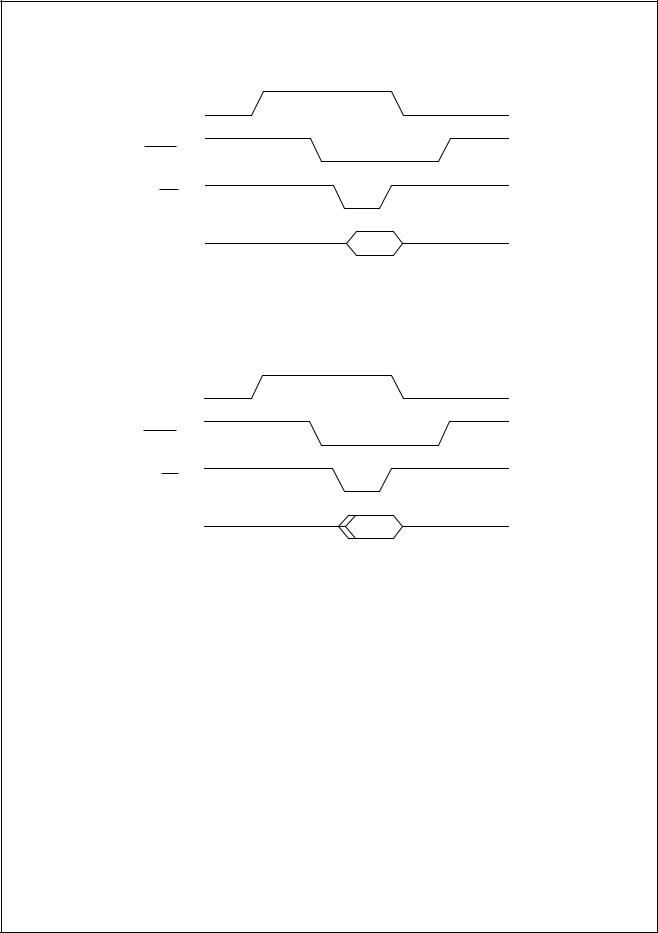
4.0 Direct Memory Access (DMA) Support (Continued)
DRQ |
|
DACK |
|
WR |
|
D7-0 |
Input |
Figure 12. DMA Write to USBN9603
DRQ |
|
DACK |
|
RD |
|
D7-0 |
Output |
Figure 13. DMA Read from USBN9603
www.national.com |
18 |
